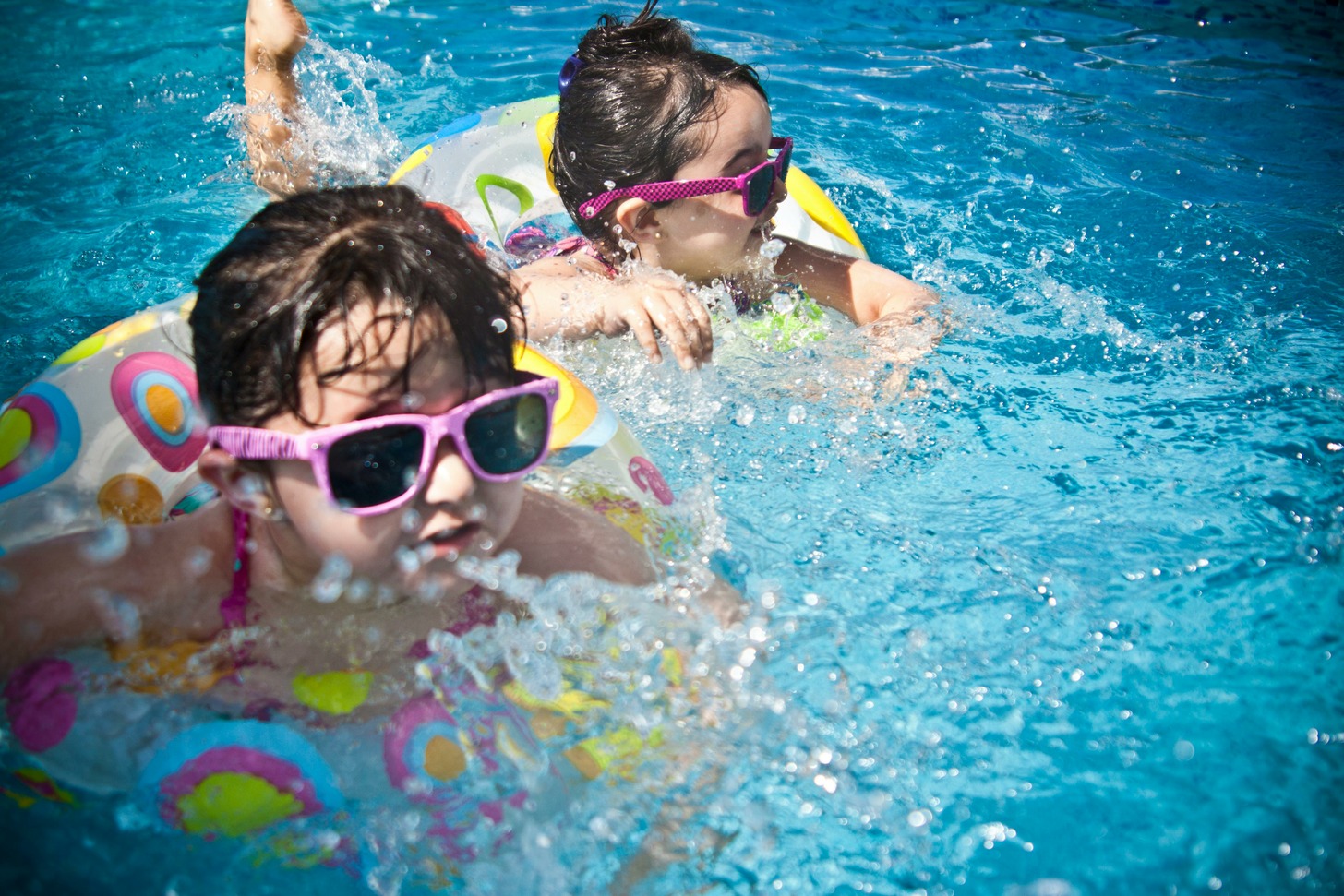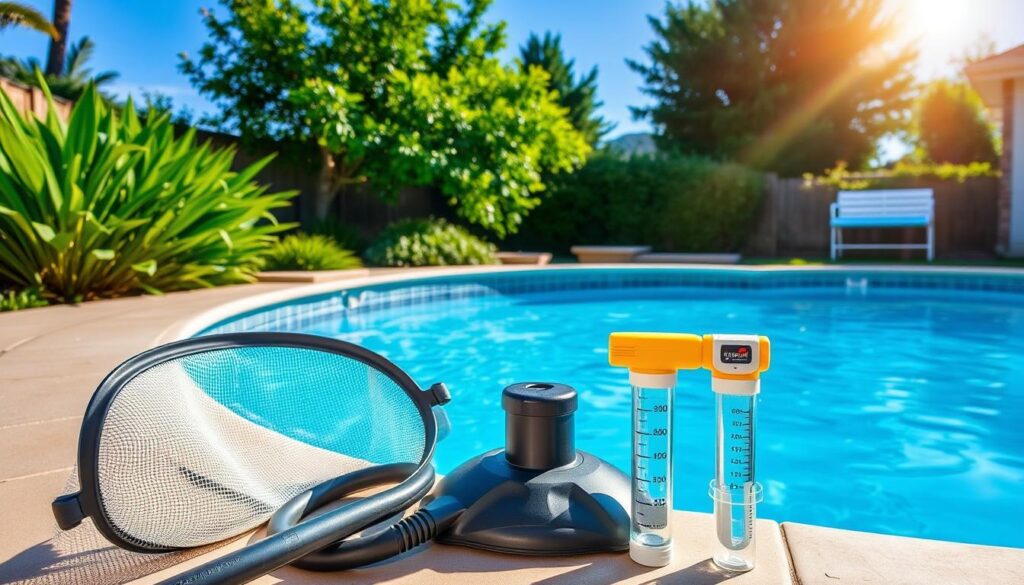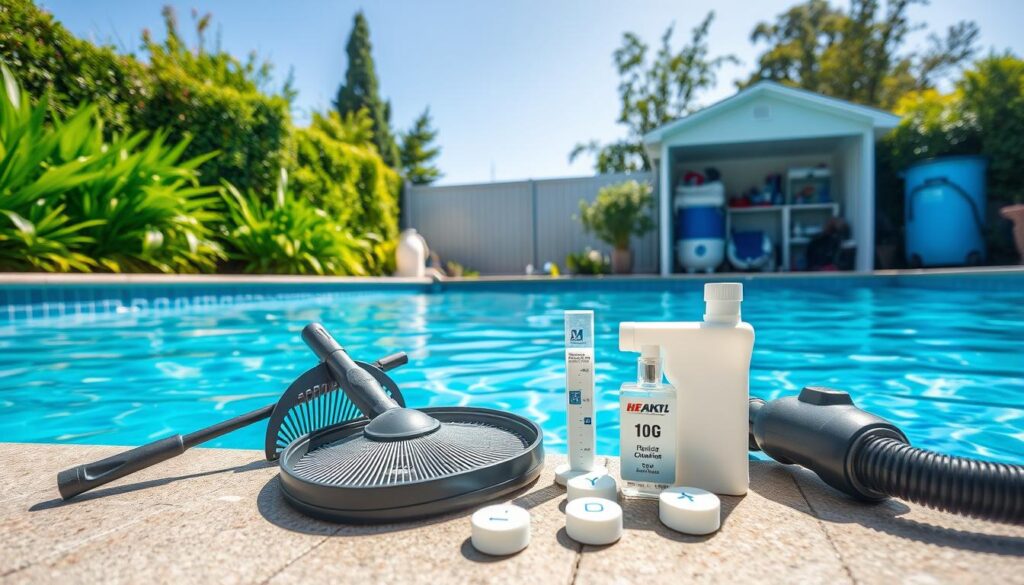$500 off Remodels and $1000 off Heaters for the month of January!
- Home
- pool maintenance

Ready to learn all about pool maintenance? Proper maintenance is key for a great swimming experience. This guide covers the basics of pool care. You’ll learn about pool parts, water chemistry, and keeping equipment in top shape.
To keep your pool looking great, you need to know about its key parts. The pool pump moves the water and the pool filter catches dirt. Each part is vital for a clean and safe pool. Let’s explore what each component does.
The pool’s heart is its water system. It has skimmers, returns and a main drain. Skimmers pull water into the filter and returns send clean water back. Good circulation keeps the water quality high and prevents it from getting still.
The pool filter is key to keeping the water clean. It catches dirt and other bad stuff. There are three types: sand, diatomaceous earth (D.E.) and cartridge. Each needs regular care to work well.
The pool’s surfaces like walls floors and pool liners are important too. They need regular cleaning to stop algae and keep the pool safe and looking good.
Knowing how these parts work helps you take better care of your pool. This way your pool will stay a beautiful spot for fun for many years.
| Pool Component | Function |
|---|---|
| Skimmer | Draws water into the filtration system, removing surface debris |
| Main Drain | Helps circulate water and remove debris from the pool floor |
| Suction Lines | Carry water from the pool to the pump |
| Pump | Circulates water through the filtration system |
| Filter | Traps dirt, debris, and contaminants from the water |
| Return Lines | Carry the filtered water back into the pool |
| Return Jets | Distribute the clean, filtered water evenly throughout the pool |
Keeping the right chemistry in your pool is key for a safe and fun swim. Focus on pH levels, alkalinity and sanitizer levels.
The perfect pH for pool water is 7.2 to 7.8. This slightly alkaline balance makes chlorine work better and prevents corrosion or skin problems. Total alkalinity should be 180 to 120 parts per million (ppm) to keep the pH stable.
Sanitizer levels, like chlorine, bromine, or salt-based systems, need regular checks. Aim for 3.0 to 5.0 ppm chlorine. Also, don’t forget to do shock treatments to get rid of dirt and keep water clear.
Testing your pool water often with good test kits is vital. It helps you adjust the chemistry and keep the water safe and welcoming for swimmers.
By keeping up with these basic pool chemistry rules, you’ll have a clean, comfy, and worry-free swim season.
“Maintaining the proper chemical balance in your pool is crucial for the health and safety of swimmers. Regular testing and adjustment of pH, alkalinity and sanitizer levels is essential for keeping your pool sparkling clean and inviting.”
Don’t forget, the team at Hillsborough Pool Service is ready to help with your pool chemistry and water treatment needs. With over 12 years of experience, we can guide you to keep your pool perfect all season.
Keeping your pool clean and working well needs the right tools. You’ll need pool vacuums, skimmer nets and pool brushes for basic cleaning. Also don’t forget water testing kits and safety gear. Having the right tools is key for good pool care.
It’s important to keep the pool water chemistry right for safety and health. Use test kits like test strips or liquid kits to check pH, alkalinity and sanitizer levels.
Pool safety is a top priority. You’ll need safety gear like pool covers, fences and first aid kits. Pool covers and fences help prevent accidents and unauthorized access.
With the right tools and safety gear, your pool will stay clean, balanced and safe for years of fun.
| Equipment | Purpose | Estimated Replacement Timeline |
|---|---|---|
| Pool Filters | Remove dirt, debris, and impurities from pool water | Typically need replacement once per year, though some higher-capacity filters may last longer |
| Pool Liners | Provide a durable, waterproof surface for the pool | Need to be replaced every several years to every decade |
| Basic Pool Equipment | Includes pumps, filters, and other essential components | Around $500 for basic equipment, with replacement parts costing up to $5,000 or more |
“Investing in the right pool maintenance equipment and tools is the key to keeping your pool in top condition and ensuring the safety of your family and guests.”
Keeping your pool clean and working well needs daily and weekly care. You’ll need to check water levels and do shock treatments. These steps help your pool stay perfect all season.
Begin your daily routine by checking the water level and making sure water circulation is right. Skim the surface to get rid of debris that built up overnight.
For weekly cleaning, do a deeper clean. Use a pool brush to clean walls and steps and vacuum the floor to get rid of dirt or sediment. Also, check the filter and replace it if needed. Make sure the pool jets are working right. Finally, do a shock treatment to keep the water clear.
Doing daily and weekly pool maintenance stops big problems and keeps your pool looking great. Spending a bit of time each day and week means you can enjoy a clean pool all season.
| Task | Frequency | Purpose |
|---|---|---|
| Check water level | Daily | Maintain optimal water circulation |
| Test and adjust pH and chlorine | Weekly | Ensure water chemistry is balanced |
| Skim pool surface | Daily | Remove floating debris |
| Brush walls and steps | Weekly | Prevent algae growth and maintain cleanliness |
| Vacuum pool floor | Weekly | Remove settled dirt and sediment |
| Clean or replace filter | Weekly | Ensure efficient water filtration |
| Inspect and clean jets | Weekly | Maintain proper water circulation |
| Perform shock treatment | Weekly | Oxidize contaminants and maintain water clarity |

“Consistent daily and weekly pool maintenance is the key to keeping your swimming area in top shape all season long.”
Keeping your pool water chemistry right is key for a safe swim. It’s about managing pH, alkalinity and chlorine levels. Plus, knowing when to shock the pool is important for pool owners.
It’s vital to keep your pool’s pH between 7.2 and 7.8. This ensures your sanitizer works well and prevents skin and eye problems. Also, keeping alkalinity levels between 80 to 120 ppm stabilizes pH and stops sudden changes.
Chlorine is the top choice for sanitizing pools, aiming for 3 to 5 ppm. Bromine is also used, with levels of 3 to 5 ppm. Testing and adjusting these levels regularly keeps your pool water clean and safe.
Shock treatments with chemicals like calcium hypochlorite or sodium dichloro-s-triazinetrione are needed to remove dirt and stop algae. Always follow the instructions and safety tips when using pool chemicals.
| Pool Chemical | Purpose | Ideal Range |
|---|---|---|
| Chlorine | Sanitizer | 3 – 5 ppm |
| Bromine | Sanitizer | 3 – 5 ppm |
| pH | Water Balance | 7.2 – 7.8 |
| Alkalinity | Water Balance | 80 – 120 ppm |
Knowing about pool chemicals and water balance helps keep your pool safe and fun all season.
Keeping your pool clean is key for looks and safety. But, issues like algae, cloudy water, and discoloration can ruin it. Luckily, you can stop and fix these problems with the right steps.
Algae is a big problem in many pools, making them green. To stop it, keep the sanitizer levels and pH balance right. Shock treating your pool weekly can help a lot, especially for algae. Shocking pools in the evening helps them work better.
Cloudy water comes from bad pH, dirt, or a clogged filter. To clear it, improve water flow, balance chemicals, and use clarifiers. Regular upkeep and filter cleaning stop clogs from debris.
Discolored water might mean metals like copper or iron are present. Fixing this means keeping the chemical balance right and finding the cause fast. Too much chemical can also cloud the water, showing why balance is crucial.
By tackling pool problems early and often, you can keep your pool looking great all season. Regular care, the right chemical mix, and quick action to problems are the secrets to a clean pool.
| Problem | Cause | Solution |
|---|---|---|
| Algae Growth | Imbalanced sanitizer levels and pH | Maintain proper sanitizer levels and pH, shock treat weekly |
| Cloudy Water | Dirt, debris or inefficient filtration | Improve circulation, adjust chemical balance, use water clarifiers and clean filters |
| Water Discoloration | Presence of metals (copper, iron, manganese) | Maintain proper chemical balance and address root cause |

“Shock treating your pool weekly can solve 90% of the most common pool problems.”
Keeping your pool in shape all year is key. From summer pool care to winterizing the pool and spring pool opening, each season needs its own plan. This ensures your pool stays in great shape.
Your pool gets a lot of use during the summer. This means you’ll need to clean it more and add chemicals. Run the water system for 10-16 hours daily to keep it clean.
Do shock treatments often, like after it rains to clean the water. Keep chlorine levels between 3-5 ppm.
A pool has four key parts: water, pool surfaces, a filtration system, and a circulation system.
Knowing pool chemistry is vital. It keeps the water clean and safe. It focuses on pH levels, alkalinity, and sanitizer levels.
You’ll need cleaning tools, water testing kits, safety gear, and automatic pool cleaners.
Daily tasks include checking water levels and ensuring it circulates well. Weekly tasks include brushing, vacuuming, water test, and shock treatments.
Issues like cloudy water and algae can be fixed with the right chemical balance and circulation. Acting quickly is also key.
Seasonal care means more cleaning and chemical checks. You also need to prepare your equipment for summer and winter.
Regular care keeps your pool safe and clean. It also makes swimming more enjoyable and extends your pool’s life.